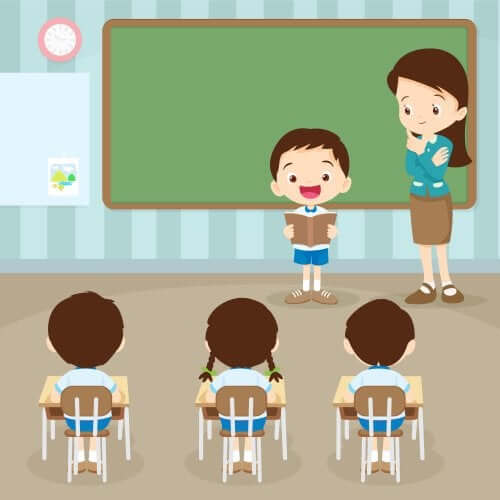Activities to Promote Reading in the Classroom


Written and verified by the teacher Azucena Fernández
Teachers often face challenges in their classrooms: getting their students to read and, above all, to do so for pleasure. That’s why it’s important to have a wide range of activities to promote reading in the classroom and know how to execute them.
It’s obvious that students have to read their school texts, but what about the rest of the day? Will they want to read outside the classroom?
To become an avid reader for life, it’s important to develop a love for reading right when you start developing reading skills. If a child doesn’t like to read when they’re small, they probably won’t do it when they’re older.
The family environment is very important for children in all aspects. In addition, it plays a role in creating reading habits and a love for reading. The key to getting children to read is often for their parents to do the same.
If children have parents who read at home, it’s much more likely that they’ll believe that reading is appealing, something you do because you want to and because it’s fun.
Can teachers do something to encourage reading in the classroom? In this article, we compiled some ideas to motivate children and help create a love of reading.
Activities to promote reading in the classroom
Teachers read
Children should know that all teachers, not just those that teach language or literature, read books. A good idea to encourage reading in the classroom is for the teachers to bring some of their favorite books to the classroom.

Before they start any lesson, the teacher can read the book they love so much aloud to the class for about five minutes. This will awaken the interest of the students in this and other books.
Reading walls
The environment is fundamental. It’s about creating an environment in class to ensure that the subject of reading is always present. A good idea to encourage reading in the classroom is to create reading walls. It’s a creative, fun and easy idea.
In these walls, the students or teachers have to leave a picture, a phrase, or something visual every time they start reading a new book. It’s a great way to share recommendations. All students will want to participate, read, and share.
Reading challenges
Reading challenges are a great incentive to make children want to read. These challenges will have symbolic prizes at the end of the school year. For example, medals, diplomas, and even some books.
Extreme reading
It’s a good challenge for children. It encourages children to take pictures reading in many places throughout the school year, from boat rides to train rides. Other good places to take photos are coffee shops or on the grass in a park.
The children bring the photos to class and the teacher places them in a hall where everyone can see them. As they always carry books with them, they’ll end up reading for real.
100 words to encourage reading
Each student will write a 100-word essay on a topic that interests them. If they don’t know what to write about, the teacher may have a list of proposals to choose from.
Then, all the students have to turn their essays in. After that, they’ll be handed out to their classmates, who will have to read them (it’ll be easy, as they’re short) and they’ll have to write their opinions on what they’ve read. As an argument for the students, the teacher will tell them that reading what a classmate wrote is a good way to support them, which is a valuable thing.

They’ll gradually get used to reading. As they’re short essays, the students won’t consider them difficult and, since they’re written by their classmates, they’ll spark their curiosity.
16 before 16 to promote reading in the classroom
This is an activity for teens. It challenges them to read 16 books before their 16th birthday. The teacher presents a selection of appropriate books for their age, which may spark their interest.
As it’s a challenge, they’re going to be interested in doing it. Every two or three weeks in class, the students should share the books they’re reading and see who’s close to accomplishing the challenge.
Examples of books for teens:
- To Kill a Mockingbird
- A Confederacy of Dunces
- The Catcher in the Rye
- The Hunger Games
- Wonder
- 13 Reasons Why
These simple activities will help naturally develop the love of reading in students. Gradually, the teachers can make them read for pleasure, with all the positive effects this will have on their personal development throughout their lives.
Teachers often face challenges in their classrooms: getting their students to read and, above all, to do so for pleasure. That’s why it’s important to have a wide range of activities to promote reading in the classroom and know how to execute them.
It’s obvious that students have to read their school texts, but what about the rest of the day? Will they want to read outside the classroom?
To become an avid reader for life, it’s important to develop a love for reading right when you start developing reading skills. If a child doesn’t like to read when they’re small, they probably won’t do it when they’re older.
The family environment is very important for children in all aspects. In addition, it plays a role in creating reading habits and a love for reading. The key to getting children to read is often for their parents to do the same.
If children have parents who read at home, it’s much more likely that they’ll believe that reading is appealing, something you do because you want to and because it’s fun.
Can teachers do something to encourage reading in the classroom? In this article, we compiled some ideas to motivate children and help create a love of reading.
Activities to promote reading in the classroom
Teachers read
Children should know that all teachers, not just those that teach language or literature, read books. A good idea to encourage reading in the classroom is for the teachers to bring some of their favorite books to the classroom.

Before they start any lesson, the teacher can read the book they love so much aloud to the class for about five minutes. This will awaken the interest of the students in this and other books.
Reading walls
The environment is fundamental. It’s about creating an environment in class to ensure that the subject of reading is always present. A good idea to encourage reading in the classroom is to create reading walls. It’s a creative, fun and easy idea.
In these walls, the students or teachers have to leave a picture, a phrase, or something visual every time they start reading a new book. It’s a great way to share recommendations. All students will want to participate, read, and share.
Reading challenges
Reading challenges are a great incentive to make children want to read. These challenges will have symbolic prizes at the end of the school year. For example, medals, diplomas, and even some books.
Extreme reading
It’s a good challenge for children. It encourages children to take pictures reading in many places throughout the school year, from boat rides to train rides. Other good places to take photos are coffee shops or on the grass in a park.
The children bring the photos to class and the teacher places them in a hall where everyone can see them. As they always carry books with them, they’ll end up reading for real.
100 words to encourage reading
Each student will write a 100-word essay on a topic that interests them. If they don’t know what to write about, the teacher may have a list of proposals to choose from.
Then, all the students have to turn their essays in. After that, they’ll be handed out to their classmates, who will have to read them (it’ll be easy, as they’re short) and they’ll have to write their opinions on what they’ve read. As an argument for the students, the teacher will tell them that reading what a classmate wrote is a good way to support them, which is a valuable thing.

They’ll gradually get used to reading. As they’re short essays, the students won’t consider them difficult and, since they’re written by their classmates, they’ll spark their curiosity.
16 before 16 to promote reading in the classroom
This is an activity for teens. It challenges them to read 16 books before their 16th birthday. The teacher presents a selection of appropriate books for their age, which may spark their interest.
As it’s a challenge, they’re going to be interested in doing it. Every two or three weeks in class, the students should share the books they’re reading and see who’s close to accomplishing the challenge.
Examples of books for teens:
- To Kill a Mockingbird
- A Confederacy of Dunces
- The Catcher in the Rye
- The Hunger Games
- Wonder
- 13 Reasons Why
These simple activities will help naturally develop the love of reading in students. Gradually, the teachers can make them read for pleasure, with all the positive effects this will have on their personal development throughout their lives.
All cited sources were thoroughly reviewed by our team to ensure their quality, reliability, currency, and validity. The bibliography of this article was considered reliable and of academic or scientific accuracy.
- Barrera-Rea, E. J., García-Herrera, D. G., Mena-Clerque, S. E., & Erazo-Álvarez, J. C. (2020). Estrategias tecnológicas para fomentar la lectura en niños de 5 a 7 años. CIENCIAMATRIA, 6(1), 464-484. https://www.cienciamatriarevista.org.ve/index.php/cm/article/view/342/430
- Braxton, Barbara. (2004). Encouraging students to read for pleasure. Teacher Librarian.
- González Álvarez, Cristóbal. (2000). Estrategias y procedimientos para fomentar la lectura en la familia y en la escuela. https://ruc.udc.es/dspace/bitstream/handle/2183/8101/LYT_15_2000_art_7.pdf
- Tigre, N. I. M., Herrera, D. G. G., Álvarez, J. C. E., & Zurita, I. N. (2020). Genially como estrategia para mejorar la comprensión lectora en educación básica. CIENCIAMATRIA, 6(3), 520-542. https://dialnet.unirioja.es/descarga/articulo/8318357.pdf
- Villa-Castro, T. M., García-Herrera, D. G., Cárdenas-Cordero, N. M., & Erazo-Álvarez, J. C. (2020). El cómic como estrategia para fomentar la lectura comprensiva. CIENCIAMATRIA, 6(1), 485-511. https://cienciamatriarevista.org.ve/index.php/cm/article/view/343/432
This text is provided for informational purposes only and does not replace consultation with a professional. If in doubt, consult your specialist.








